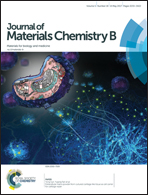Biodegradable nanoparticles as siRNA carriers for in vivo gene silencing and pancreatic cancer therapy
Abstract
The clinical application of RNA interference (RNAi)-based cancer gene therapy has been hampered by the lack of efficient delivery of short interfering RNA (siRNA). In this context, the use of biodegradable charged polyester-based vectors (BCPVs) for delivering mutated K-Ras-targeting siRNA in a pancreatic xenograft model was investigated in vivo. Using mice bearing pancreatic xenografts as an animal model, results show that fluorescently labeled TRAMA (carboxytetramethylrhodamine) K-Ras siRNA continuously accumulated in the xenograft via BCPVs for at least 72 h. After the treatment, the level of the targeted mRNA and protein reduced to 50% of their original level. As a consequence, significant suppression in tumor growth, decreased tumor local infiltration, and increased cell apoptosis were observed in the xenograft model after the siRNA treatment. More importantly, physiological analysis results reveal that an excessive amount of BCPV (10 times higher than the commonly treated amount) will not have a significant influence on the status of the blood stream, blood stream components, and organ tissue, suggesting that BCPVs have very low in vivo toxicity. Our results indicate that the delivery of K-Ras-targeting siRNA via BCPV nanoparticles may be a promising strategy for pancreatic cancer therapy.



 Please wait while we load your content...
Please wait while we load your content...